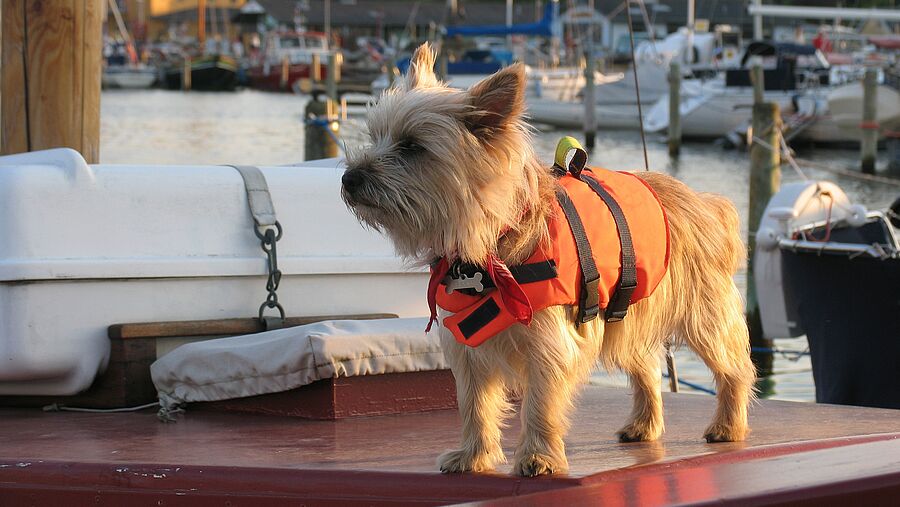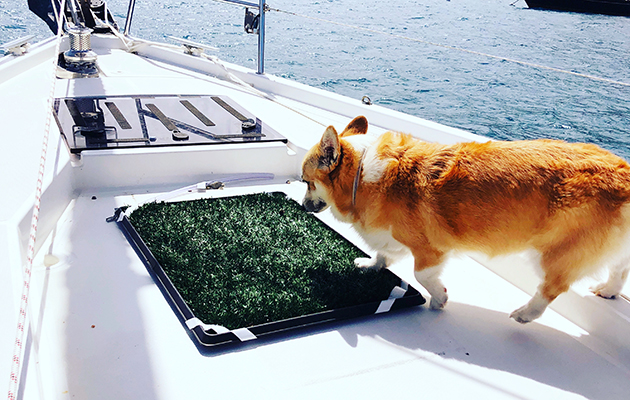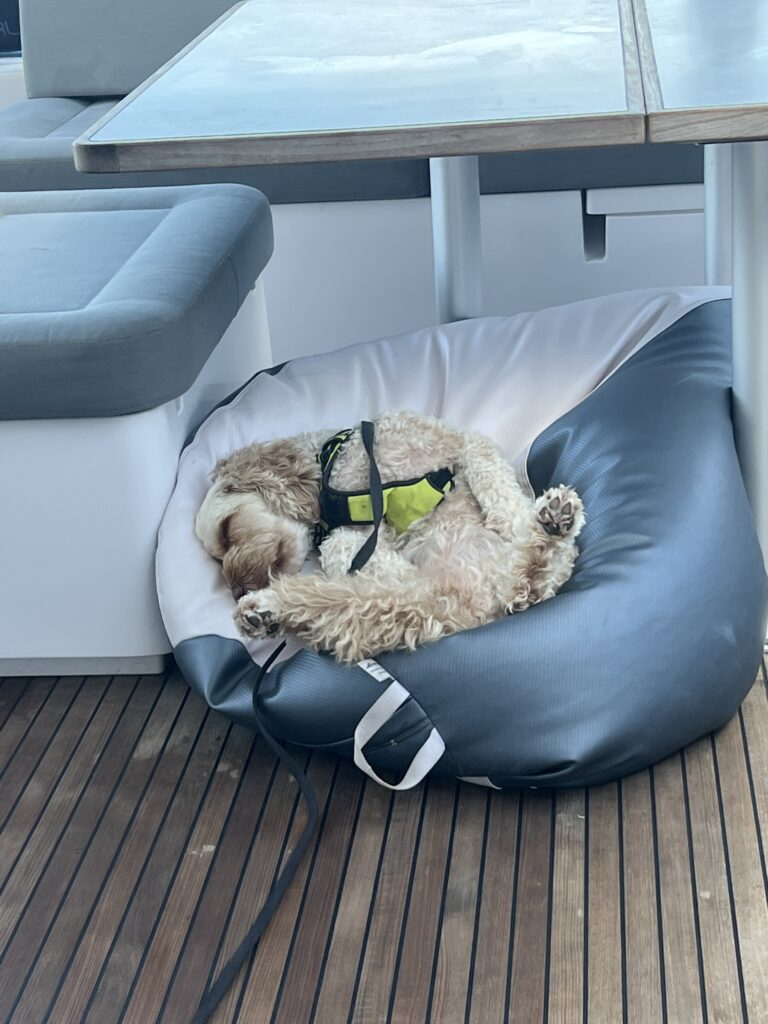Dogs on board sailing yachts
For many yacht owners, life on the water is the ultimate escape. The sea offers freedom, adventure, and peace. But for dog lovers, no journey is complete without their four-legged companion. Taking a dog aboard a yacht can be an enriching experience—provided it’s done with careful planning and ongoing care.
Here’s how to ensure your dogs stay happy, healthy, and safe at sea.
1. Know Your Dog’s Temperament
Not all dogs are natural sailors. Some breeds—Labradors, Portuguese Water Dogs, and Spaniels—enjoy the water and adapt well to life on a boat. Others may struggle with the motion or the confined space. Before committing to extended voyages, test short trips to assess your dog’s comfort level.
Excessive panting, shaking, or restlessness can be signs of discomfort. If your dog suffers from motion sickness, consult a vet about anti-nausea medications designed for dogs. Vets can also prescribe doggy valium for those nights when the chop and thunder may be too much for your dog.
2. Safety First: Life Jackets and Training
Even strong swimmers need protection. Every dog on board should wear a properly fitted canine life jacket with a handle for easy lifting. Choose high-visibility colours and ensure your dog is accustomed to wearing them before embarking.

Train your dog to return to the boat via a pet-friendly ladder or ramp. Practice dog-overboard drills for your pet—if they fall in, you must know how to retrieve them safely.
3. Onboard Comfort and Potty Solutions
Dogs need a designated place to relieve themselves. For many yacht owners, this is one of the biggest logistical challenges. Options include:
- Artificial grass pads with a drainage system.
- Real sod patches in a tray (biodegradable but temporary).
- Pee pads, although not always suitable in windy conditions.

Train your dog to use its designated potty spot while docked before heading offshore. Our dog Pepper held on for three days on a more extended voyage, which I’m sure hurt my bladder more than hers. In desperation, and on advice from Google, I had to christen the potty mat personally before she would use it.
Ensure your dog has a shaded, non-slip spot to rest, away from lines, winches, or other hazards. Non-skid mats, plenty of fresh water, and regular breaks are essential to keep them comfortable.

4. Health and Legal Requirements
If you’re crossing borders, your dog will likely need vaccination records, a microchip, and possibly a pet passport or international health certificate. Each country has its import laws, some of which require quarantine.
Before you leave, visit a vet for a complete check-up and keep copies of medical records in a waterproof folder. Tell your vet what your plans are so they can prescribe more medication than normally would be allowed to suit your longer voyages.
5. Local Cruising vs. International Travel with Dogs
Caring for a dog in your local waters is relatively simple, but once your bow points to international horizons, the rules change significantly.
Local (Domestic) Cruising
In most countries, domestic coastal cruising with a dog is straightforward:
- No special documentation is needed.
- Veterinarian care is readily accessible.
- Quarantine laws do not apply.
Still, be aware of:
- Marine parks or protected wildlife areas may restrict pets.
- Although not recommended, you may have to do a sneaky run to the beach early in the morning or later at dusk to give your dog some ball-chasing time…
- Leash laws and dog access regulations in small harbours and on local beaches.
International Travel: What Changes?
Travelling with a dog between countries can be complex and requires serious planning.
1. Pet Import Regulations
Each country has its laws regarding pet importation. These often include:
- Microchipping (ISO-standard chip)
- Valid rabies vaccination certificate
- Tapeworm and tick treatments
- Health certificates issued by a certified vet
- In some cases, quarantine periods
For example:
- New Zealand and Australia have strict quarantine and biosecurity rules.
- European Union countries may accept pets under the EU Pet Passport scheme.
- Caribbean nations often require advance import permits and up-to-date documentation.
2. Quarantine
Some countries will require dogs to be quarantined for several days or weeks. The facilities vary in quality and can be expensive.
3. Entry Ports
Not all marinas or anchorages accept animals. Many countries require entry through a designated port where customs, immigration, and animal health authorities can inspect the pet.
4. Cruising Permits and Island Hopping
In regions like the South Pacific or the Caribbean, where different countries govern islands, you may face differing dog entry requirements every time you move to a new island, even if they are geographically close.
Documentation to Keep Onboard
For international travel, always carry:
- Pet passport or international health certificate
- Rabies vaccination record
- Microchip registration info
- Recent vet check certificate
- Photos of your dog (for identification)
- List of upcoming countries and their pet regulations
Store these documents in a waterproof binder, and keep digital backups.
6. Exercise and Stimulation
Space is limited onboard, so mental stimulation becomes crucial. Bring toys and puzzle feeders, and schedule regular playtime. If conditions allow, let your dog swim near the boat with a long line attached or go ashore frequently for walks. If you are north of Cairns, consider the crocodiles for you and your dog.
7. Emergency Preparedness
Always have a first aid kit tailored to your pet. Items might include:
- Bandages and antiseptic
- Seasickness medications
- Tweezers and tick removers
- Flea and heartworm preventatives
- Spare leash, collar, and ID tags
Know the location of the nearest veterinary clinics along your route, just in case. Include your dog’s needs in your passage planning. Read more about passage planning.
Final Thoughts
Dogs thrive on companionship, routine, and stimulation—all of which can be maintained on a yacht with proper planning. With safety precautions, training, and love, your dog can become a loyal crew member, sharing sunsets at anchor and breezy days at sea.
For yacht owners, there’s nothing like watching your best friend lean into the wind, tail wagging, or conversing with some passing dolphins…

If you have a dog on board your sailing boat, please share your story in the comment box below…
Author
-

Rene is a keelboat instructor and sailing coach in the Mandurah area WA. He is also the author of several books about sailing including "The Book of Maritime Idioms" and "Renaming your boat".
View all posts


